Moselle River Route
Moselle River Route: from Konz to Koblenz
We can give you at least three reasons why a Moselle road trip will be forever etched in your mind: the wild, intimate charm of the river; the many traces of Roman civilisation dating back to the 2nd century and the amazing wines, (especially the Rieslings) born in the slate soil and raised on the steep hillsides above the river.Expect pure driving pleasure as you navigate the 200-kilometre stretch from Konz to Koblenz with its dozen or so 180-degree hairpins whilst admiring the panoramic views from the vistas above the river valleys.
There’s never a dull moment as you follow winding river roads or take detour trips through vineyards to fairy-tale medieval castles perched high on the hills.
It goes without saying, but any wine stops detailed on this page are for the benefit of hire car passengers ... designated drivers must confine themselves to drinking in the scenery.
Book a rental car now and explore Germany
Konz: where Saar and Moselle meet
Your road trip starts in Konz, where Saar and Moselle meet. But first stretch your legs and visit Kaiservilla, the magnificent remains of a Roman villa built around 350 AD which resides above the meeting point of the rivers. Civilisation as we know it began here about 1,000 years before the rest of Germany caught on.Konz is a picturesque town and boasts two vineyards of the highest order, Hövel and Reverchon, and both cordially invite visitors to taste and purchase wine at their respective premises. A friendly reminder: don’t drink and drive is the motorist’s mantra.
If you do plan on tasting the delicate Moselle rieslings with their dry, slatey finish, we suggest an overnight stay at the Mühlenthaler Park Hotel in Konz.
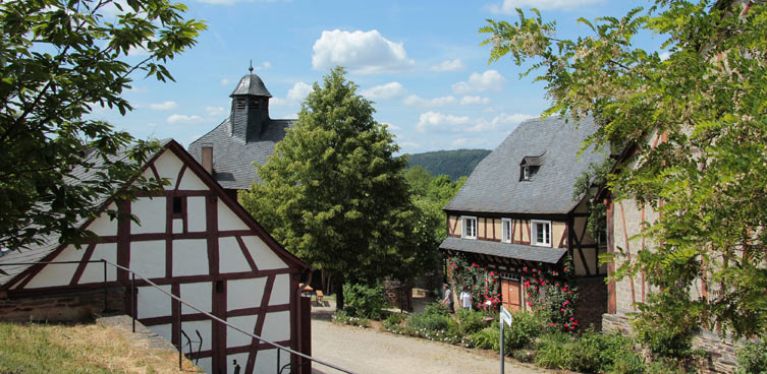
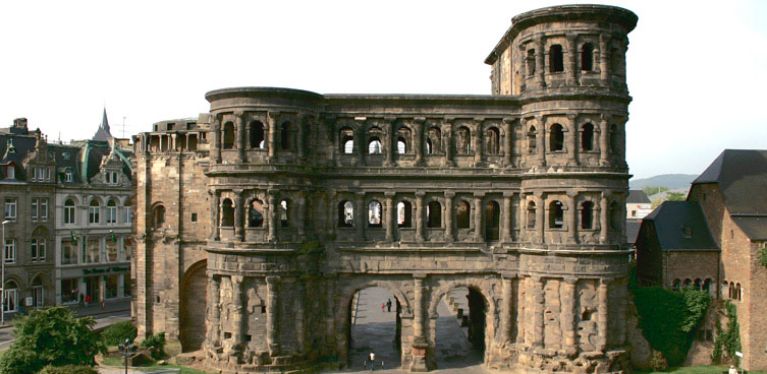
Trier: Roman Heritage Site
Full of cultural and culinary delights, Trier was founded by the Romans in 16 BC as Augusta Treverorum and is Germany’s oldest city. The Romans left an indelible mark on the city, one of their legacies being Porta Nigra, a mighty city gate which has survived remarkably intact since the 2nd century.As a UNESCO Heritage Site, Trier is full of monuments to the multi-faceted lifestyle once enjoyed by the Romans: the Imperial Thermal Baths was, in the 4th century, one of the largest in the entire Roman Empire. Today you can admire the baths at ground level or explore the underground complex. The old Amphitheatre used to hold a crowd of 20,000 while today it is an lovely, authentic setting for summer concerts. Other similarities between Trier and Rome spring to mind: Rome is on the Tiber, Trier is on the Moselle. Also, Trier has long been an influential religious centre, which can be seen in the majestic St Peter’s Cathedral, Germany’s oldest bishopric, as well as the gothic Liebfrauenkirche. Trier is the birthplace of Karl Marx and the house in the old town where he was born has been turned into a museum.
Back on the scenic route: via Leiwen to Piesport
So far you’ve had a full helping of culture and history … now let’s get this show on the road! It’s only 45 kilometres to Piesport, but long enough for several loops to test the driver’s mettle: first and foremost the 180-degree hairpin between the wine towns of Leiwen and Trittenheim. Between the curves, marvel at the steep hillsides either side of the river which are surely the signature features of this leg.After arriving in Piesport, admire the reconstructed 4th century Roman fermentation system for an insight into the history of the ancient craft of wine-making. Weingut Reinhold Haart is a modern producer who sets the highest local and international standards of quality.
Leaving Piesport, we turn off the main road (the B53) along the river to Minheim and continue on the L50, a winding scenic road above the river with stellar panoramic views across the sweeping curves of the river. This leg is a gorgeous 25-kilometre trip and leads you to Bernkastel-Kues.
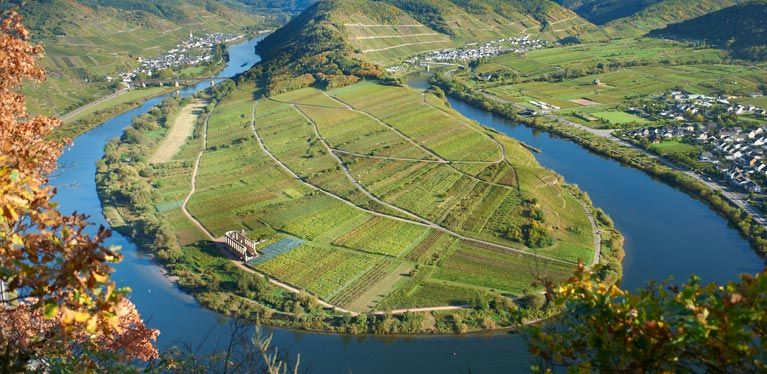
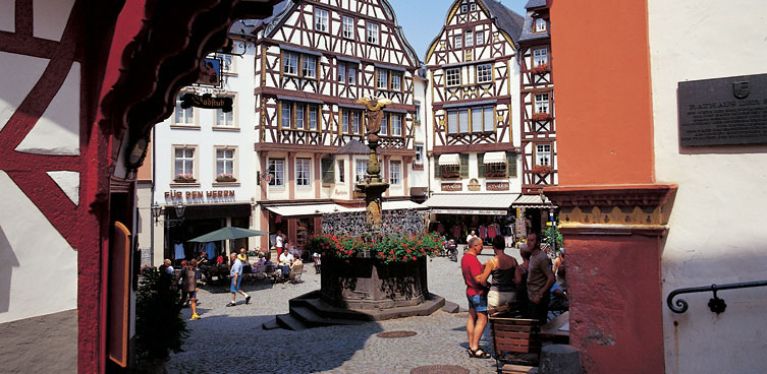
Bernkastel-Kues: good taste, good river
Bernkastel-Kues is a true gem on the river with a must-see historical old town bursting with fairy-tale half-timbered houses and a lively marketplace where St Michael’s Fountain and the renaissance Rathaus are well worth a closer look.The list of wine producers in and around Berncastel-Kues reads like a Who’s Who of the German wine industry. A few may sound familiar, such as Schloss Lieser, Dr Loosen or Joh Jos Prüm. The mission here is clear: find a hotel, park the car and find the nearest wine bar.
A great way to get a feel for the local wine industry is to visit the multimedia Moselle Wine Museum which has a wine bar and shop with around 160 wines on offer. Another option is to visit the local vineyards, many of which have tasting rooms where you can enjoy the wine, get some local insights and have a friendly chat.
After all the wine-tasting, round off your visit with a stylish overnight stay at the Burgblick Hotel.
Moselle loops: Bremm via Traben-Trarbach
The Moselle is famed for its amazing loops and bends, but none are more spectacular than on the next 70 kilometres to Cochem. No less than six 180-degree loops await you, including those near Kröv. To get the best views of the river and surrounding scenery, it’s a good idea to leave the road along the river once in a while and climb up into the hills above. A good option here is near Kröv; take the K63 and K62 to the ruined castle of Mont Royal before getting on the K64 back to the river at Traben-Trarbach, where you pass through a striking art nouveau gate and cross the river.This route takes you through traditional wine-producing villages such as Zell and Bremm, where the iconic Calmont vineyard is Europe’s steepest with a 60-degree slope. Make a pit stop at the Weingut Franzen in Bremm who own some of the vines on this near-vertical slope. Our recommended overnight stop on this leg is Hotel-Restaurant Hutter in Bremm.
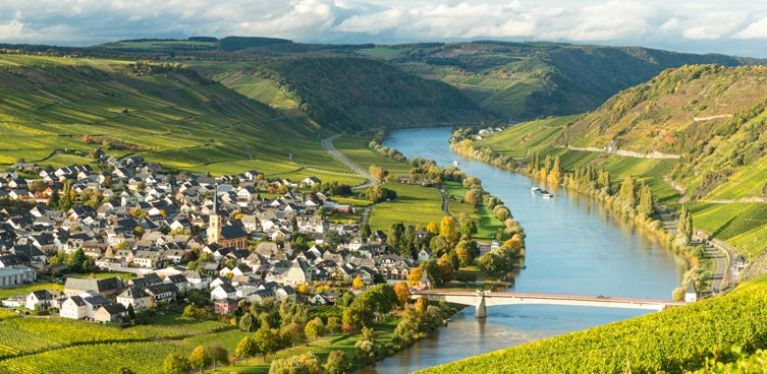
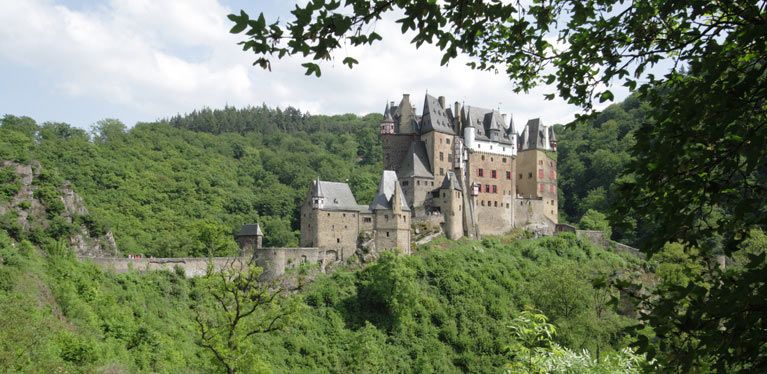
The land of castles: from Cochem to Koblenz
Wine is a recurring theme all the way to Koblenz, so it’s now time to change focus and take a closer look at the fascinating “castle country” along the Moselle. The late-gothic Reichsburg near Cochem is an iconic example, you can take a tour then relax in the castle hostelry and savour the stunning view of the Moselle flowing 100 metres directly below.After Cochem the Moselle straightens out and takes a more direct route, but the scenery is no less impressive. You pass the fairy-tale Burg Eltz and rugged Burg Thurandt, two contrasting medieval structures along the way. Keep your driving skills sharp on the curvy K72 through the wild charm of the Ehrbachtal and up to Ehrenburg castle, taking the K72 by Brodenbach. This magical journey through spectacular scenery, rich in cultural and culinary delights, comes to an end in Koblenz, where Rhine and Moselle meet at the Deutscher Eck under Kaiser Wilhelm’s statue.